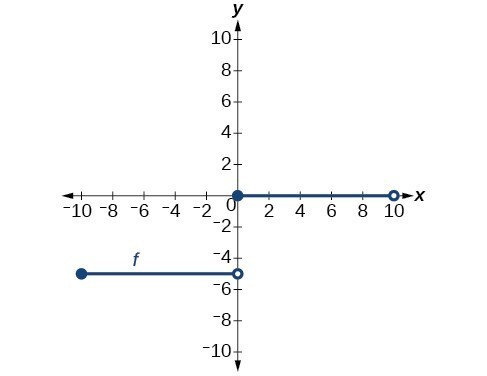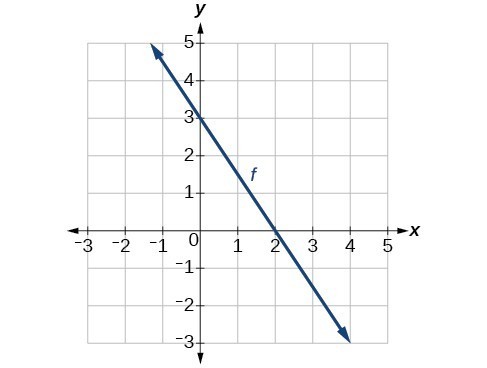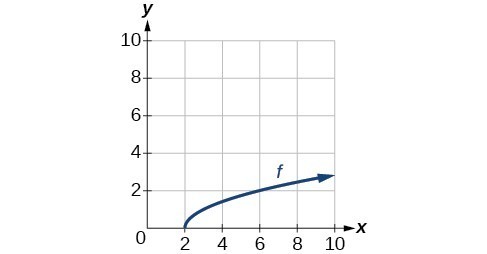Section Exercises
1. Describe why the horizontal line test is an effective way to determine whether a function is one-to-one? 2. Why do we restrict the domain of the function [latex]f\left(x\right)={x}^{2}[/latex] to find the function’s inverse? 3. Can a function be its own inverse? Explain. 4. Are one-to-one functions either always increasing or always decreasing? Why or why not? 5. How do you find the inverse of a function algebraically? 6. Show that the function [latex]f\left(x\right)=a-x[/latex] is its own inverse for all real numbers [latex]a[/latex]. For the following exercises, find [latex]{f}^{-1}\left(x\right)[/latex] for each function. 7. [latex]f\left(x\right)=x+3[/latex] 8. [latex]f\left(x\right)=x+5[/latex] 9. [latex]f\left(x\right)=2-x[/latex] 10. [latex]f\left(x\right)=3-x[/latex] 11. [latex]f\left(x\right)=\frac{x}{x+2}\\[/latex] 12. [latex]f\left(x\right)=\frac{2x+3}{5x+4}[/latex] For the following exercises, find a domain on which each function [latex]f[/latex] is one-to-one and non-decreasing. Write the domain in interval notation. Then find the inverse of [latex]f[/latex] restricted to that domain. 13. [latex]f\left(x\right)={\left(x+7\right)}^{2}[/latex] 14. [latex]f\left(x\right)={\left(x - 6\right)}^{2}[/latex] 15. [latex]f\left(x\right)={x}^{2}-5[/latex] 16. Given [latex]f\left(x\right)=\frac{x}{2}+x\\[/latex] and [latex]g\left(x\right)=\frac{2x}{1-x}\\[/latex] a. Find [latex]f\left(g\left(x\right)\right)[/latex] and [latex]g\left(f\left(x\right)\right)\\[/latex] b. What does the answer tell us about the relationship between [latex]f\left(x\right)[/latex] and [latex]g\left(x\right)?[/latex] For the following exercises, use function composition to verify that [latex]f\left(x\right)[/latex] and [latex]g\left(x\right)[/latex] are inverse functions. 17. [latex]f\left(x\right)=\sqrt[3]{x - 1}[/latex] and [latex]g\left(x\right)={x}^{3}+1[/latex] 18. [latex]f\left(x\right)=-3x+5[/latex] and [latex]g\left(x\right)=\frac{x - 5}{-3}[/latex] For the following exercises, use a graphing utility to determine whether each function is one-to-one. 19. [latex]f\left(x\right)=\sqrt{x}[/latex] 20. [latex]f\left(x\right)=\sqrt[3]{3x+1}[/latex] 21. [latex]f\left(x\right)=-5x+1[/latex] 22. [latex]f\left(x\right)={x}^{3}-27[/latex] For the following exercises, determine whether the graph represents a one-to-one function. 23. 24.
24.
 For the following exercises, use the graph of [latex]f[/latex] shown in [link].
For the following exercises, use the graph of [latex]f[/latex] shown in [link].
 25. Find [latex]f\left(0\right)[/latex].
26. Solve [latex]f\left(x\right)=0[/latex].
27. Find [latex]{f}^{-1}\left(0\right)[/latex].
28. Solve [latex]{f}^{-1}\left(x\right)=0[/latex].
For the following exercises, use the graph of the one-to-one function shown below.
25. Find [latex]f\left(0\right)[/latex].
26. Solve [latex]f\left(x\right)=0[/latex].
27. Find [latex]{f}^{-1}\left(0\right)[/latex].
28. Solve [latex]{f}^{-1}\left(x\right)=0[/latex].
For the following exercises, use the graph of the one-to-one function shown below.
 29. Sketch the graph of [latex]{f}^{-1}[/latex].
30. Find [latex]f\left(6\right)\text{ and }{f}^{-1}\left(2\right)[/latex].
31. If the complete graph of [latex]f[/latex] is shown, find the domain of [latex]f[/latex].
32. If the complete graph of [latex]f[/latex] is shown, find the range of [latex]f[/latex].
For the following exercises, evaluate or solve, assuming that the function [latex]f[/latex] is one-to-one.
33. If [latex]f\left(6\right)=7[/latex], find [latex]{f}^{-1}\left(7\right)[/latex].
34. If [latex]f\left(3\right)=2[/latex], find [latex]{f}^{-1}\left(2\right)[/latex].
35. If [latex]{f}^{-1}\left(-4\right)=-8[/latex], find [latex]f\left(-8\right)[/latex].
36. If [latex]{f}^{-1}\left(-2\right)=-1[/latex], find [latex]f\left(-1\right)[/latex].
For the following exercises, use the values listed in the table below to evaluate or solve.
29. Sketch the graph of [latex]{f}^{-1}[/latex].
30. Find [latex]f\left(6\right)\text{ and }{f}^{-1}\left(2\right)[/latex].
31. If the complete graph of [latex]f[/latex] is shown, find the domain of [latex]f[/latex].
32. If the complete graph of [latex]f[/latex] is shown, find the range of [latex]f[/latex].
For the following exercises, evaluate or solve, assuming that the function [latex]f[/latex] is one-to-one.
33. If [latex]f\left(6\right)=7[/latex], find [latex]{f}^{-1}\left(7\right)[/latex].
34. If [latex]f\left(3\right)=2[/latex], find [latex]{f}^{-1}\left(2\right)[/latex].
35. If [latex]{f}^{-1}\left(-4\right)=-8[/latex], find [latex]f\left(-8\right)[/latex].
36. If [latex]{f}^{-1}\left(-2\right)=-1[/latex], find [latex]f\left(-1\right)[/latex].
For the following exercises, use the values listed in the table below to evaluate or solve.
| [latex]x[/latex] | [latex]f\left(x\right)[/latex] |
| 0 | 8 |
| 1 | 0 |
| 2 | 7 |
| 3 | 4 |
| 4 | 2 |
| 5 | 6 |
| 6 | 5 |
| 7 | 3 |
| 8 | 9 |
| 9 | 1 |
| [latex]x[/latex] | 3 | 6 | 9 | 13 | 14 |
| [latex]f\left(x\right)[/latex] | 1 | 4 | 7 | 12 | 16 |
Licenses & Attributions
CC licensed content, Shared previously
- Precalculus. Provided by: OpenStax Authored by: Jay Abramson, et al.. Located at: https://openstax.org/books/precalculus/pages/1-introduction-to-functions. License: CC BY: Attribution. License terms: Download For Free at : http://cnx.org/contents/[email protected]..
